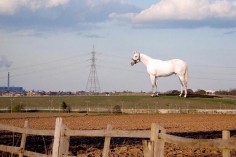MARK WALLINGER
50-metre tall White Horse
source: visualartsbritishcouncilorg
The White Horse (2013) a new sculpture by Mark Wallinger, was unveiled outside the British Council’s London headquarters on the Mall, on 5th March 2013. Made of marble and resin, the sculpture is a life-size representation of a thoroughbred racehorse created using state of the art technology in which a live horse has been scanned using a white light scanner in order to produce a faithfully accurate representation of the animal standing on a broad plinth of Portland stone and facing down The Mall.
Commissioned by the British Council Collection, this major work will stand on The Mall for two years before becoming available for international display.
In 2008, Mark Wallinger won The Ebbsfleet Landmark Project, an international competition to build a monument at Ebbsfleet in Kent. Wallinger’s winning entry, a white horse, 25 times life-size, and standing some 50 metres tall, was designed to look out over what was once Watling Street. The White Horse in Spring Gardens is a life-sized version of this sculpture.
The White Horse illustrates Wallinger’s continuing fascination with the horse, and its emblematic status in our national history. The origins of the white horse as the emblem of Kent can be traced from ‘Horsa’ – the derivation of the modern word horse – a semi-mythological Anglo-Saxon leader who landed near Ebbsfleet on the Isle of Thanet in the 6th century. The White Horse sculpture relates to the ancient history of hillside depictions of white horses in England but the pose is familiar from current depictions of thoroughbred stallions and has been replicated throughout the history of art from Stubbs’ painting of Eclipse to Wallinger’s own paintings of stallions from the Darley Stud.
The Thoroughbred was first developed at the beginning of the 18th century in England, when native mares were crossbred with imported Arabian stallions. Every racehorse in the world is descended from these animals. 90% from the Darley Arabian, the most dominant influence on the breed.
The proximity of the equestrian statues of Charles I and George IV on Trafalgar Square, and the Piazza’s location only a stone’s throw from Horse Guards Parade, make the siting of this sculpture particularly resonant. As does the fact that The Mall remains a processional route of cavalry parades..
.
.
.
.
.
.
.
source: tateorguk
English painter, sculptor and video artist. He studied in London at the Chelsea School of Art (1978–81) and Goldsmiths College (1983–5). From the mid 1980s his work has addressed the traditions and values of British society, its class system and organised religion. The range of approaches he has adopted reflects his wish to have a broad appeal and highlights his roots in a tradition of British left-wing thought. In the early 1990s he began using a personal enthusiasm for horse racing as a theme through which to explore issues of ownership and pedigree.
In the late 1990s Wallinger shifted his focus to a questioning of institutionalised spirituality and religion. The skepticism and irreverence of his work, typical of his humorous observational approach, were downplayed in a later public sculpture commissioned for the Fourth Plinth in Trafalgar Square: Ecce Homo (marbleised resin, barbed wire, gold leaf, 1999). Close to the edge of the massive stone plinth, Wallinger placed a life-sized cast of a young man representing Christ being presented by Pontius Pilate to the Judeans. This work suggested contemporary relevance for themes of suffering and redemption, and a plea for racial and religious tolerance. Wallinger has described his approach in terms of the address of the chorus to the audience in classical Greek theatre, suggesting both an authentic absorption and personal investment in the work as well as a real critical distance. Wallinger was shortlisted for the Turner Prize in 1995.
.
.
.
.
.
.
.
source: lespressesdureel
Mark Wallinger (né en 1959 à Chigwell, Grande-Bretagne) s’intéresse, à travers différents médiums mis en œuvre avec intelligence et humour (peinture, vidéo, installation), aux thèmes liés à la religion, à la politique et à l’identité culturelle. Il a représenté la Grande-Bretagne à la Biennale d’art contemporain de Venise en 2001 et a remporté le Prix Turner en 2007.


